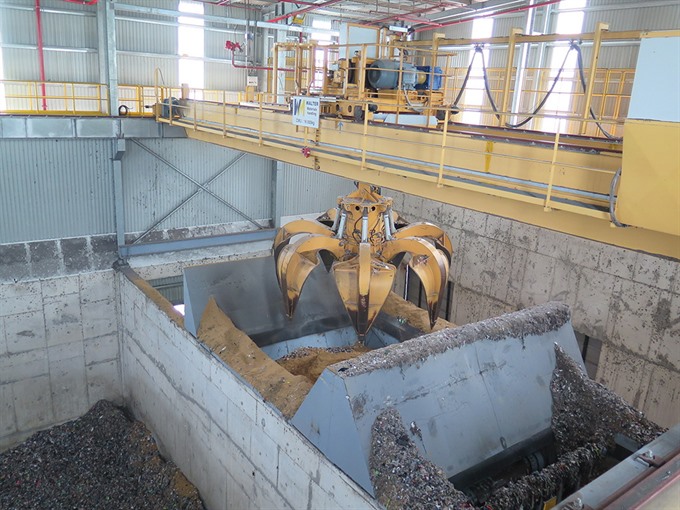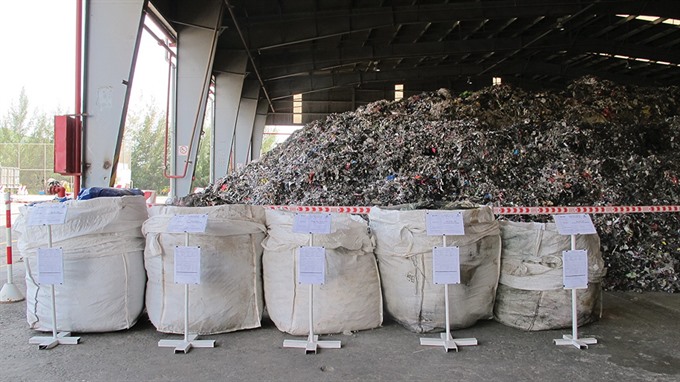Co-processing, solution for industrial waste
With its rapid industrialisation and
population growth, Việt Nam produces more than 15 million tonnes of waste a
year, including 4.7 million tonnes of solid industrial waste, according to
the Ministry of Natural Resources and Environment.
The
waste is mainly treated by landfilling or burning in industrial incinerators.
The environmental impact of waste from industry,
especially the footwear industry, has been the focus of attention in recent
years due to its use of many hazardous chemicals and discharge of large
amounts of leather, rubber and PVC, which are hard to decompose under natural
conditions.
Footwear development,
waste generation
HCM City -- Việt Nam is the third largest
footwear maker in Asia and fourth in the world (behind China, India and
Brazil), accounting for about 10 per cent of global production.
Leather and footwear products are also a key export item for the
country, accounting for 10 per cent of revenues.
The Ministry of Industry and Trade recently unveiled a plan for the
development of the country’s leather and footwear industry.
It expects exports of leather and footwear to increase 10-15 per cent
a year between 2016 and 2020 and 8-9 per cent the next five years.
There are around 1,700 companies in this sector employing 1.2 million
workers.
However, too much of anything is not good, especially with the
footwear industry having a huge environmental impact.
With the development plan, the lack of a controlling and monitoring
system and funds shortage make the need for effective waste management and
treatment solutions more important than ever.
Prof Dr Nguyễn Mai, chairman of the Association of FDI enterprises,
once talking about the wave of FDI investment in the footwear industry in
Việt Nam, has warned that the industry poses a high risk of pollution and
therefore it is necessary to select suitable projects to avoid environmental
disasters.
World Bank economist Phạm Minh Đức said: “Investments in the upstream
sector must be accompanied by stricter environmental regulations because the
[footwear] industry discharges a large volume of wastewater and pollutants.
So Việt Nam is at risk of using toxic chemicals. To mitigate these impacts,
Việt Nam needs to have policies that encourage the use of advanced and
environmentally friendly technologies."
Under increasing pressure from consumers, society and the Government,
the footwear industry is seeking ways to become more sustainable.
Though manufacturers would like dearly to be sustainable and
environment-friendly, there are limitations with respect to the information
they have about technologies and their adoption due to financial issues.
According to experts, 25 per cent of the leather used is discharged
and causes bad odour.
Đức said: “Burning wastes from the footwear industry creates large
amounts of dioxin. If not treated with the right method, it will have fatal
impacts on human beings.
“Even storing this kind of waste in the wrong manner causes chemicals
to leak into soil and water, destroy the environment and damage public
health.”
At the end of last year a factory owned by Đào Quang Việt in Kiến An
District, Hải Phòng city, which burnt footwear waste, was severely criticised
by neighbors. Vietnam Law newspaper carried out an investigation and found
that the 1,200sq.m facility stored a huge amount of rubber and leather shoe
soles and PVC.
The facility has a two-metre high fence, but dumps waste outside.
Residents of Lâm Hà Ward reported that the plant’s main work was recycling
footwear waste into plastic, and its 20-metre chimney discharged swirling
black fumes day and night.
In 2011 the footwear industry was involved in a serious case of
violation of waste treatment laws in Bình Phước Province.
The Đồng Xoài town police inspected a facility belonging to Thái Bình
Leather and Footwear Company in Tân Đồng Ward, and discovered it landfilled
solid wastes in front and directly discharged effluents without treatment.
The inspection uncovered that the plant had landfilled more than 160
cubic metres of PVC, plastic packaging, PU and other wastes.
The management blamed the company’s partner, a waste treatment
company, for it. It had stopped its work due to several problems. Every day
the facility discharged one cubic metre of waste, and the electricity company
insisted it should clear the waste so that it could do construction.
Solution
While waste management in certain industries has been a perennial
problem in Việt Nam with State agencies being responsible for finding
solutions for waste management and garbage disposal, some corporate players
are forging ahead with modern technologies to resolve the problem and draw
closer to nature.
Large footwear companies have also been looking for long for ways to
reduce and eliminate the practice of landfilling waste.
Việt Nam’s most popular waste disposal methods are incineration and
landfilling. However, handling the waste generated daily is becoming more and
more of a problem as the technology at incineration plants is very basic and
therefore insufficient.
Though these plants are assessed by the Government for technical
standards and gas emissions, Việt Nam lacks the technology to identify
dioxins and other pollutants.
Garbage collectors are not sufficiently monitored or tracked, and
their backyard facilities have insufficient waste treatment capabilities.
This poses a serious threat to people and the environment as ground and
surface water are often contaminated by this untreated waste.
“Consequently, efficient waste management is one of the biggest social
and environmental challenges,” a sustainability report by a footwear
manufacturer said.
“One proven alternative and possible solution on the way to a ‘zero
waste society’ in Việt Nam is the so-called ‘co-processing’ technology with
the help of which waste is transformed into thermal heat to produce cement
with strict quality control.”
Co-processing: transform disposal waste
Co-processing makes best use of the 2000 degree Celcius heat in cement
kilns to completely destroy waste, leaving no residues for landfilling and
thus reducing CO2 (carbon dioxide) emissions.
Geocycle, a waste management brand of Holcim (now Insee), takes over
wastes from a wide range of footwear manufacturers in Việt Nam and has so far
converted 690,000 tons of industrial waste, which would have affected even
groundwater if dumped into the environment.
Its work has a triple benefit – waste management, contributing to a
cleaner environment; reduction in the consumption of fossil fuels with the
generation of energy from the waste; and thus reduction in emission of
greenhouse gases.
Nguyễn Thành Danh, an independent environmental evaluator told Việt
Nam News that Geocycle is a pioneering company in waste management offering
professional and environmental-friendly waste disposal.
He said its method is a globally established best practice to dispose
of hazardous wastes. It is technically advanced and superior to landfilling
and incineration since there are no residues.
“Though the price for this treatment is higher than for burning, it
brings a lot of benefits to society by discharging nothing into the
environment.”
Co-processing is recognised and encouraged by international
institutions such as the World Health Organization, World Business Council
for Sustainable Development, Hazardous Chemical and Waste conventions, the
Basel Convention, The European Cement Association, and GTZ (German Technical
Corporation).
A report released at the 2015 national environment conference showed
there were almost 458 solid waste landfills in Vieät Nam with an area of more
than 1 hectare each and countless smaller landfills. An efficient solution is
needed for this.
Large
attention should be drawn to co-processing.
Viet Nam News, By Hoàng Hà

Co-processing
proved to be more effective than incineration thanks to no residues being
left out

Footwear
waste is completely destroyed by the heat of 2000 celcius in the cement kilns
|
Thứ Sáu, 26 tháng 5, 2017
Đăng ký:
Đăng Nhận xét (Atom)

Không có nhận xét nào:
Đăng nhận xét